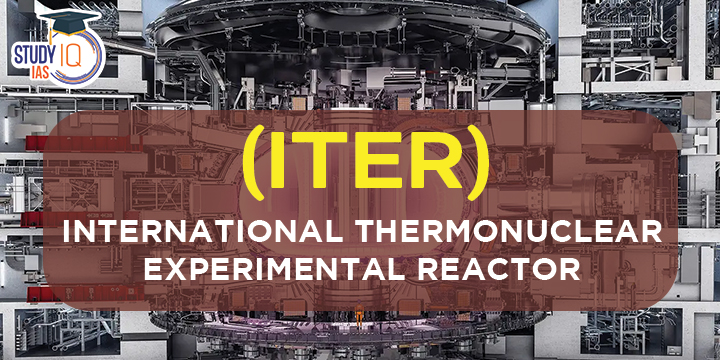Table of Contents
International Thermonuclear Experimental Reactor (ITER): About
- The International Thermonuclear Experimental Reactor (ITER) is an international collaboration between seven countries to demonstrate nuclear fusion as a clean source of unlimited energy.
- International Thermonuclear Experimental Reactor (ITER) will be the first fusion device that will test the integrated technologies, materials, and physics regimes needed for the commercial production of fusion-based electricity.
- International Thermonuclear Experimental Reactor (ITER) is known as the world’s largest tokamak.
- Partners:
- China, the European Union, India, Japan, Korea, Russia and the United States are the countries that have collaborated on a 35-year collaboration to build and operate the International Thermonuclear Experimental Reactor (ITER) experimental device.
- The members will share of the cost of project construction, operation and decommissioning.
- The experimental results and any intellectual property generated by the fabrication, construction and operation phases will also be shared.
- Europe will contribute the largest portion of construction costs (45.6 percent); the remainder is shared equally by others (9.1 percent each).
International Thermonuclear Experimental Reactor (ITER): More on the News
- India’s Institute for Plasma Research (IPR) has supplied approximately four km of cryolines and about six km of return lines for warm gases.
- The IPR has also contributed to the completion of the assembly of top lid sectors of the cryostat.
Tokamak
- A tokamak is a machine that holds plasma using magnetic fields in a donut shape. It is designed to harness the energy of fusion.
- The tokamak has been adopted around the world as the most suitable configuration of magnetic fusion device.
- Working:
- The device will use extreme heat and pressure to convert gaseous hydrogen fuel into plasma.
- The charged particles of the plasma can be controlled by the massive magnetic coils placed around the walls.
- The heat generated during fusion will be used to produce steam and then electricity by way of turbines and generators.
Nuclear Fusion
- Fusion is the source of energy for the Sun and stars. Hydrogen nuclei collide, fuse into heavier helium atoms and release tremendous amounts of energy during the process.
- The process releases energy because the total mass of the resulting single nucleus is below the mass of the two original nuclei.
- The most efficient fusion reaction in the laboratory setting would be the reaction between two hydrogen isotopes, deuterium (D) and tritium (T).
- Conditions for nuclear fusion:
- Very high temperature (about 150,000,000° Celsius)
- Sufficient plasma particle density (to increase the likelihood of collisions)
- Sufficient time of confinement (to hold the plasma)
- Benefits of nuclear fusion energy:
- No radioactive waste
- High efficiency
- Inexpensive fuel
- No greenhouse gases are emitted
- High energy density
- No risk of meltdown of reactor



 Daily Quiz 05 July 2025
Daily Quiz 05 July 2025
 SSC MTS Apply Online for 1075 Posts – ...
SSC MTS Apply Online for 1075 Posts – ...
 Dynamic Pricing: What It Is and Why It's...
Dynamic Pricing: What It Is and Why It's...





















